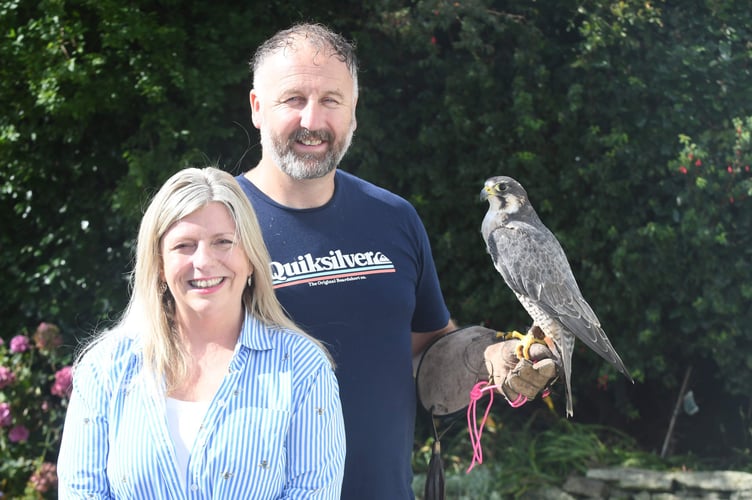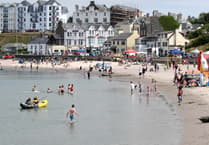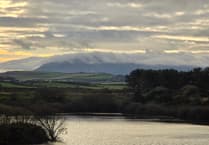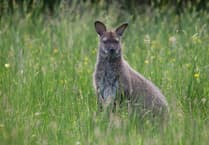John Corteen’s passion is wildlife, especially birds. He is licensed to hold owls and raptors, including our precious, red-listed hen harriers, and is the chosen contact for rescuing and rehabilitating these birds.
He and his wife Tina live on a smallholding near the top of one of the most beautiful valleys in the island where they have created a haven for birds and other wildlife.
When they first came to view the property, John spotted a kestrel and a buzzard on the lane leading to it. His immediate reaction was: ‘We’ve got to live here.’
Tina recalls the night they moved into the Colby property: ‘We were literally carrying our bed upstairs when John got a call to say there was an injured owl. He said: “I’m going to have to go and rescue this owl.”
‘I said: “No you’re not someone else can do it”.
“I’ll only be half an hour,” he said – three hours later he got back.’
She adds: ‘John loves his birds. I’ve been carried along on the wave, if the truth be told.’
As well as the birds of prey – harriers, hawks, buzzards, kestrels, merlin’s, peregrines, short and long eared owls, barn owls – swallows, house sparrow, blue tits, great tits, long tailed tits, skylark, cuckoo, chough, crossbill, curlew, whitethroat, starling, blackbird, black cap, thrush, redwing, fieldfare, wren, yellow wagtail, grey wagtail, pied wagtail, great spotted woodpecker, magpie, warbler, mistle thrush, crow, rook, raven, jackdaw, robin, wheatear, stonechat, redpoll, green finches, gold finches, gold crest, grey partridge, red grouse, woodcock, snipe and many more species, some of them red listed as endangered, have made their homes on John and Tina’s land and in the surrounding area.
They currently have two peregrines recuperating with them, they live alongside John’s other birds a goshawk, a hybrid peregrine and, John’s favourite, a spectacular red-tailed hawk named Kara.
Vera Barber, the Hedgehog Lady of Peel, uses their land to release hedgehogs safely back into the wild.
Partly to protect the birds and other wildlife from disturbance John and Tina have never talked publicly before about the avian treasure trove they have. But now the whole area, its nature and wildlife is threatened and, ironically, the threat comes from something which should be part of helping the environment, rather than destroying it: the announcement of Earystane and Scard, their home, as one of the proposed sites for an onshore wind farm.
‘We just wanted to enjoy what’s here but now’s the time to talk about what we do, to try and save it,’ says Tina.
And John adds: ‘I one hundred per cent agree that we have to have green energy but not at any expense.’
The proposed site, which is less than 500 metres from their home and tourism business, is near the top of the valley.
It will mean the felling of huge numbers of trees in the Earystane plantation, this means the loss of habitat, some native trees and the destruction of surrounding heathland to make way for, not just the 150- to 200-metre high turbines, but also the roadways that will need to be constructed for lorries and contractors’ vehicles to come onto the site and then the on-going access and maintenance of the wind turbines.
So how is the idea that this site is suitable justified in environmental terms?
Under current planning law, a full Environmental Impact Assessment of the whole site should take place before the proposal even goes to planning. However, already there is much use in official communications of the term ‘Biodiversity Net Gain’. This can generally be a good idea as it means that when, for example, a developer builds a small estate of houses, they have to plant trees and introduce other measures to encourage wildlife which will generally leave the area with ‘10% more biodiversity’ than it started with.
However, when applied to a site as ecologically precious as Earystane and Scard, it is not just a ludicrous concept: it is patently unachievable, as John explains.
He says: ‘Since we came here just over five years ago, we’ve planted getting on for 1,000 trees. I did have a lease on the old reservoirs near our property. When we got here, the big reservoir had no water in it. Obviously, for wildlife, water’s a huge thing so I said I’d pay to get repairs done on it, rent or buy so we could get the water back in.
John adds: ‘We always had a good smattering of raptors but it’s the small birds where we’ve really seen the difference.’
‘Now they have said they might have to use the reservoir site and the land around it for Biodiversity Net Gain. It’s absolute rubbish. There’s no room for more trees to go in so I don’t know what it is they think they’re going to put in there or why they have taken me off. They have been provided with photographs showing the planting, wildlife and improvements over the years.’
Tina adds: ‘The idea of the tree planting was to keep the wildlife corridor going: it starts at Cringle plantation and it goes over Cringle park, goes to Earystane then to us. Other neighbours and farms have done some planting too, and then there’s the plantation that’s just been planted by the Woodland Trust/Commissioners by Tom the Dipper’s, [at the top of Ballakillowey] so the idea is that nature has pathways to hop along and we’ve already seen the fruits of our labour on that.’
In another irony, DEFA’s flagship Agri Environment Scheme is designed to help our nature and wildlife by rewarding farmers for doing exactly what John is doing.
John says: ‘It’s conflicting if government on the one hand is saying to me: “Manage the uplands in harmony with wildlife and we’ll pay you to do that”, to then go: “Actually we’re not really bothered about that, we can move that to one side, we can do these biodiversity credits if we just wilfully disturb these sites.’
John adds that he has never taken any funding from government for wildlife projects and tree planting. His major concern is for the safety of his birds of prey, the resident birds and those he rehabilitates: ‘they just get clubbed by wind turbines’, but it is goes far beyond that.
The supporting infrastructure pylons and cabling often injures these magnificent birds. It’s also about the destruction of their whole habitat, including their source of food.
John says: ‘As an apex predator birds of prey will only survive if there’s food for them to eat. They are a good indication of what wildlife is like as a whole picture – if there’s no food they won’t survive and they’ll move on somewhere else or they’ll just stop breeding and perish. We will lose the very commodity we have nurtured for years and we won’t get it back’.
As Tina says: ‘We’re just blessed to live here but this is what we bought. We wanted to live here and enjoy it as our forever home and then leave something behind, a living legacy of nature. We don’t have children and it was about giving something back. That’s a true “Green Agenda” surely.’


.jpeg?width=209&height=140&crop=209:145,smart&quality=75)


Comments
This article has no comments yet. Be the first to leave a comment.